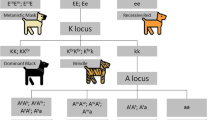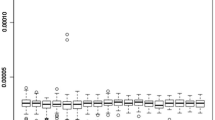Abstract
Common white and facial markings have a multifactorial mode of inheritance inEquus caballus and result from the absence of melanocytes in the unpigmented areas. Directional asymmetry and fluctuating asymmetry apparently account for the total asymmetry of common white leg markings. Using computerized records obtained from the Arabian Horse Registry of America, Inc., and the International Arabian Horse Association, studies were carried out to determine if homozygosity increases the total asymmetry in common white leg markings by presumably promoting fluctuating asymmetry. The results were as follows: (1) Arabian horses that are symmetrical and asymmetrical for common white leg markings have similar distributions of inbreeding coefficients; (2) Arabian and half-Arabian horses have similar concordance values, in general, for specific white markings in both their forelegs and hind legs. It is concluded that homozygosity does not contribute to the total asymmetry of common white leg markings in the Arabian horse.
Similar content being viewed by others
References
Clarke, G. M., B. P. Oldroyd & P. Hunt, 1992. The genetic basis of developmental stability inApis mellifera: heterozygosity versus genic balance. Evolution 46: 753–762.
Crowell, P., 1951. Cavalcade of American Horses. McGraw-Hill, New York.
Dobzhansky, T., 1950. Genetics of natural populations. XIX. Origin of heterosis through natural selection in populations ofDrosophila pseudoobscura. Genetics 35: 288–302.
Dreux, P., 1966. Introduction statistique a la genetique des marques blanches limitees chez le cheval domestique. Ann. Genet. 9: 66–72.
Forbis, J., 1976. The Classic Arabian Horse. Liveright, New York.
Geurts, R., 1977. Hair Colour in the Horse. J. A. Allen, London.
Leamy, L., 1984. Morphometric studies in inbred and hybrid house mice. V. Directional and fluctuating asymmetry. Am. Nat. 123: 579–593.
Leary, R. F., F. W. Allendorf & K. L. Knudsen, 1984. Superior developmental stability of heterozygous enzyme loci in salmonid fishes. Am. Nat. 124: 540–551.
Leary, R. F., F. W. Allendorf & K. L. Knudsen, 1992. Genetic, environmental and developmental causes of meristic variation in rainbow trout. Acta Zoologica Fennica 191: 79–96.
Lerner, I. M., 1954. Genetic Homeostasis. Wiley, New York.
Livshits, G. & E. Kobyliansky, 1991. Fluctuating asymmetry as a possible measure of developmental homeostasis in humans: A review. Hum. Biol. 63: 441–466.
Markow, T. A. & J. P. Ricker, 1991. Developmental stability in hybrids between the sibling species pair,Drosophila melanogaster andDrosophila simulans. Genetica 84: 115–121.
Markow, T. A. & J. P. Ricker, 1992. Male size, developmental stability, and mating success in natural populations of threeDrosophila species. Heredity 69: 122–127.
Mather, K., Genetical control of stability in development. Heredity 7: 297–336.
Mintz, B., 1967. Gene control of mammalian pigmentary differentiation. I. Clonal origin of melanocytes. Proc. Nat. Acad. Sci. 58: 344–351.
Mintz, B., 1974. Gene control of mammalian differentiation. Annu. Rev. Genet. 8: 411–470.
Nebe, H. D., 1984. Die Farbevererbung beim Pferd unter besonder Berucksichtigung der Vererbung weisser Abseichen (Inaugural dissertation). Fachbereich Veterinarmedizin und Tierzucht, Justus-Liebig-Universitat, Giessen, Germany.
Palmer, A. R. & C. Strobeck, 1992. Fluctuating asymmetry as a measure of developmental stability: Implications of non-normal distributions and power of statistical tests. Acta Zool. Fennica 19157–72.
Seidel, G. E., Jr. & R. P. Elsden, 1987. Why identical twins may be different. Hoard's Dairyman 132: 740.
Sponenberg, D. P. & B. V. Beaver, 1983. Horse Color. Texas A & M University Press, College Station.
Thoday, J. M., 1955. Balance, heterozygosity and developmental stability. Cold Spring Harbor Symp. Quant. Biol. 20: 318–326.
Van Valen, L., 1962. A study of fluctuating asymmetry. Evolution 16: 125–142.
Waddington, C. H., 1942. Canalization of development and the inheritance of acquired characters. Nature 150: 563–565.
Waddington, C. H., 1957. The Strategy of Genes. McMillan, New York.
Woolf, C. M., 1989. Multifactorial inheritance of white facial markings in the Arabian horse. J. Hered. 80: 173–178.
Woolf, C. M., 1990. Multifactorial inheritance of common white markings in the Arabian horse. J. Hered. 81: 250–256.
Woolf, C. M., 1991. Common white facial markings in bay and chestnut Arabian horses and their hybrids. J. Hered. 82: 167–169.
Woolf, C. M., 1992. Common white facial markings in Arabian horses that are homozygous and heterozygous for alleles at the A and E loci. J. Hered. 83: 73–77.
Woolf, C. M. & J. R. Swafford, 1988. Evidence of eumelanin and pheomelanin producing genotypes in the Arabian horse. J. Hered. 79: 100–106.
Zakharov, V. M., 1992. Population phenogenesis: analysis of developmental stability in natural populations. Acta Zool. Fennica 191: 7–30.
Author information
Authors and Affiliations
Rights and permissions
About this article
Cite this article
Woolf, C.M. Does homozygosity contribute to the asymmetry of common white leg markings in the Arabian horse?. Genetica 89, 25–33 (1993). https://doi.org/10.1007/BF02424503
Accepted:
Issue Date:
DOI: https://doi.org/10.1007/BF02424503




